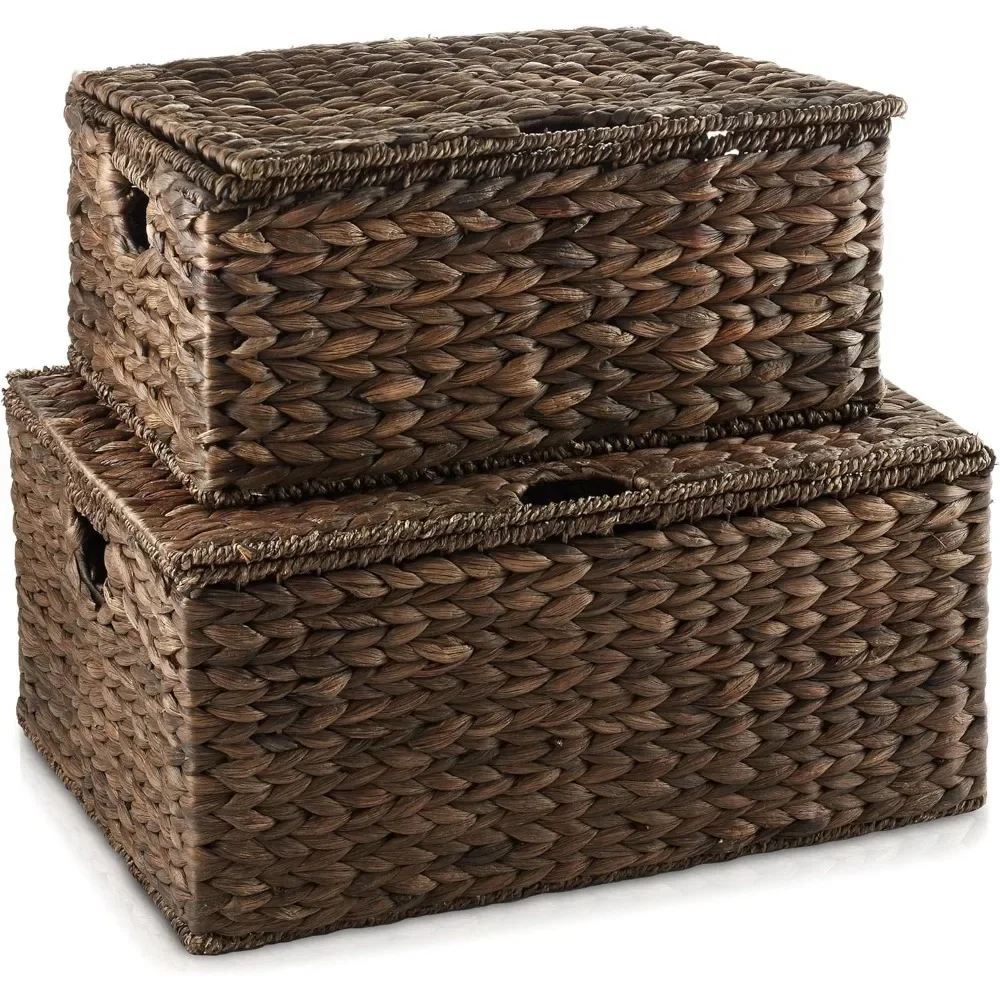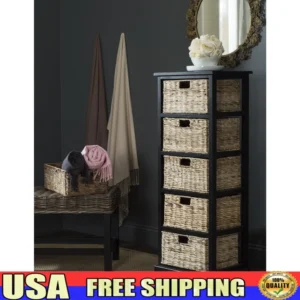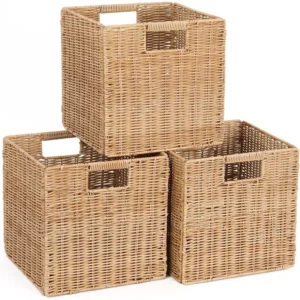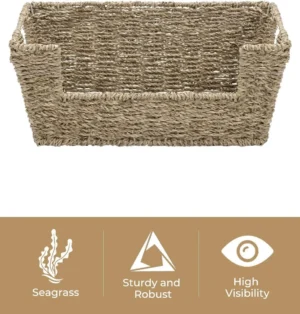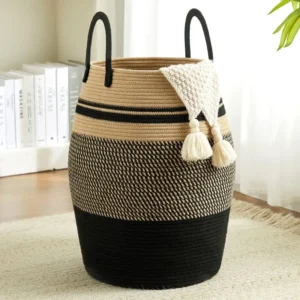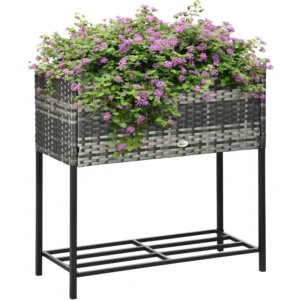Introduction: The Purpose of Matching Storage Baskets in Home Design
Storage baskets have evolved from purely functional items to essential design elements in today’s homes. Matching storage baskets represent the perfect marriage between organization and aesthetics—they not only contain clutter but do so while enhancing your interior design. When we talk about “matching” in this context, we’re referring to storage solutions that harmonize with your existing decor while creating visual cohesion throughout your space.
The dual benefit of well-chosen baskets cannot be overstated. They transform chaotic areas into orderly spaces while simultaneously elevating your home’s visual appeal. Unlike plain plastic containers that simply hide belongings, thoughtfully selected baskets can become statement pieces that reflect your personal style.
Research suggests that visual clutter can increase stress hormones and decrease focus by up to 15%, making organized spaces not just visually pleasing but psychologically beneficial. The growing trend of “functional decor”—items that serve both practical and aesthetic purposes—has made matching storage baskets a cornerstone of modern interior design.
Understanding the foundation of matching baskets in home design helps you create spaces that feel intentionally designed rather than just organized. Throughout this guide, we’ll explore how to select and incorporate the perfect storage baskets that align with your unique interior style while meeting your organizational needs.
Why Coordinated Storage Solutions Elevate Your Interior Design
Coordinated storage baskets do more than just hold your belongings—they communicate intentionality and design consciousness. When storage elements match or complement each other throughout your home, they create a sense of visual coherence that elevates the entire space.
The difference between an “organized” space and a “designed” space often comes down to these thoughtful details. Consider a living room before and after a storage makeover: initially, it might have various mismatched containers scattered about, creating visual noise. After introducing coordinated baskets—perhaps in complementary natural materials with similar tones—the same space appears deliberately styled and harmonious.
This transformation occurs because matching storage baskets provide:
- Visual rhythm through repeated elements that guide the eye
- A sense of calm through reduced visual chaos
- An impression of thoughtful curation rather than haphazard organization
- Decorative elements that enhance rather than detract from your design
- Psychological benefits from both organization and aesthetic pleasure
The design principle of repetition teaches us that repeating similar elements creates harmony and connection in a space. Matching storage baskets leverage this principle perfectly—they introduce consistent elements throughout a room or home while still allowing for variation in size, texture, or slight color differences.
Selecting stylish matching baskets transforms everyday organization from a chore into an opportunity for design enhancement. When your storage solutions are beautiful enough to display proudly, organizing becomes a pleasure rather than a burden.
Understanding Your Interior Design Style: The Foundation for Selection
Before selecting storage baskets, it’s essential to identify your predominant interior design style. Your existing furniture, color palette, and decorative elements speak a specific “design language,” and your storage solutions should continue this conversation rather than interrupt it.
Many people struggle to put a name to their personal style, but understanding basic style categories helps narrow down basket options that will complement your space. Even if your home blends several styles, you can typically identify primary influences that will guide your basket selection.
The ultimate guide to basket colors for your interior can help you determine exactly which hues will work best, but first, let’s examine how different design styles pair with specific basket types:
| Design Style | Key Characteristics | Ideal Basket Materials | Color Palette | Sample Pairings |
|---|---|---|---|---|
| Minimalist | Clean lines, uncluttered, neutral | Metal, felt, canvas | White, black, gray | White square canvas in black metal frame |
| Bohemian | Eclectic, layered textures, global | Seagrass, jute, woven | Earth tones, jewel tones | Colorful woven baskets with tassels |
| Farmhouse/Rustic | Weathered, homey, natural | Wicker, chicken wire, wood | Cream, brown, distressed | Whitewashed wicker with wooden handles |
| Modern/Contemporary | Sleek, structured, bold | Metal, acrylic, leather | Black, white, bold accents | Black metal mesh with leather trim |
| Coastal/Nautical | Airy, relaxed, natural | Rattan, seagrass, rope | Blues, whites, sandy tones | Blue-striped fabric lined seagrass |
| Traditional | Classic, timeless, detailed | Dark wicker, lined fabric | Rich woods, classic tones | Cherry-toned wicker with paisley liner |
If you’re uncertain about your style, look for patterns in your existing furnishings. Do you gravitate toward natural materials and neutral colors? You might lean minimalist or farmhouse. Do you love bold colors and varied textures? Your style may have bohemian influences. The storage baskets that will look most at home in your space will share elements with the pieces you already love.
Essential Elements for Selecting Harmonious Storage Baskets
Choosing the right storage baskets involves more than just picking something pretty. Six key factors determine whether baskets will truly harmonize with your interior: material, color, texture, size, shape, and practical features. While you might be tempted to focus primarily on one element like color, true design harmony comes from balancing all these considerations.
Think of these elements as working together to create a visual conversation between your baskets and the rest of your space. When they speak the same language, the result is a cohesive design that feels intentional and refined. Let’s explore each element to understand how they contribute to creating perfectly matched storage solutions.
Material Selection: Choosing the Right Texture and Substance
The material of your storage baskets sets the foundation for both their appearance and functionality. Different substances not only look distinctive but also perform differently depending on what you’ll store and where you’ll place them.

Natural fibers remain the most popular basket materials, each with unique characteristics:
Rattan and Wicker: These traditional rattan storage baskets offer durability and timeless appeal. Rattan provides structural strength while maintaining visual lightness. Perfect for visible areas in living rooms and bedrooms where their warm tones add natural elegance.
Seagrass and Water Hyacinth: These materials bring interesting texture and subtle variation in color. More eco-friendly than some alternatives, they add organic appeal to coastal, bohemian, or natural-themed spaces. Water hyacinth, in particular, offers exceptional durability for high-use items.
Jute and Sisal: These rougher fibers create rustic, casual baskets ideal for farmhouse or relaxed bohemian styles. Their natural durability makes them excellent for storing heavier items, though their texture might be too rough for delicate fabrics.
Fabric options offer different advantages:
Canvas and Cotton: Soft, lightweight, and easy to clean—often machine washable. Perfect for kids’ rooms, closets, and anywhere you need flexibility. Available in countless colors and patterns to match any scheme.
Felt: Provides structure without rigidity and has a distinctively modern, somewhat industrial look. Works well in contemporary spaces and offices. The soft texture prevents scratching of surfaces.
Other material options include:
Metal Wire: Perfect for industrial, modern, and farmhouse styles. Provides visibility of contents while maintaining organization. Often paired with fabric liners for storing smaller items.
Wooden Crates: Offer rustic charm and substantial structure. Can be painted or stained to match specific color schemes. Best for items that don’t require dust protection.
Synthetic Materials: Include plastic, vinyl, and eco-friendly alternatives. Provide water resistance and easy cleaning for bathrooms and kids’ spaces. Many modern options mimic natural materials with improved durability.
When selecting materials, consider:
– Moisture exposure in the intended location
– Weight of items to be stored
– Visibility (will the basket be displayed or hidden?)
– Cleaning requirements
– Sustainability preferences
The most sophisticated interiors often mix materials thoughtfully—perhaps using seagrass baskets with leather handles in a living room while employing canvas bins with similar-toned trim in adjacent bedrooms. This creates connection without monotony.
Color Harmony: Integrating Baskets into Your Color Palette
Color selection might seem straightforward, but it requires careful consideration to achieve true harmony between your storage baskets and interior design. The first step is identifying your room’s existing color scheme—both dominant colors and accent tones that appear throughout the space.
Two primary strategies exist for selecting basket colors:
The Blend-In Approach: Choose baskets in colors that match or closely complement your main furniture or wall colors. This creates a seamless look where storage recedes visually while still contributing to the overall design. This works particularly well in minimalist, Scandinavian, or monochromatic spaces.
The Accent Approach: Select baskets that pick up your room’s accent colors, creating intentional pops of color that tie into your overall scheme. This works well when you want storage to become a feature rather than just a function.
Basic color theory can guide your selections:
- Complementary colors (opposite on the color wheel) create vibrant contrasts—blue baskets in an orange-accented room make both colors appear more intense
- Analogous colors (next to each other on the color wheel) create harmonious, soothing combinations—green baskets in a blue room feel naturally connected
- Monochromatic schemes use different shades of the same color—varying tones of gray baskets create subtle dimension without introducing new colors
Natural materials like wicker baskets in Scandinavian designs exemplify how neutral baskets add warmth without disrupting a clean color palette. Their inherent variation in tone adds interest without introducing competing colors.
For maximum versatility, consider:
– Neutral exterior with colorful interior lining
– Natural materials with colored trim or handles
– Sets with graduated tones of the same color
Remember that lighting dramatically affects how colors appear—natural fiber baskets may look significantly warmer or cooler depending on your lighting conditions. Always consider your specific lighting when evaluating color harmony.
Texture and Weave: Adding Dimension to Your Space
Texture might be the most underappreciated yet impactful element in basket selection. While color and material get immediate attention, the specific texture and weave pattern of your baskets create subtle visual interest that elevates your entire space.
In interior design, contrasting textures prevent even single-color schemes from appearing flat. Woven storage baskets introduce rich textural elements that create depth and interest, particularly in minimal interiors where they might be the primary source of texture.
Common weave patterns each create distinct visual effects:
- Tight, uniform weaves project precision and order—ideal for contemporary or minimalist spaces
- Open, airy weaves create visual lightness and casual elegance—perfect for coastal or relaxed styles
- Herringbone patterns add sophisticated texture with traditional appeal
- Diamond or geometric weaves introduce subtle pattern that adds interest without overwhelming
The density of the weave not only affects appearance but also functionality. Tightly woven baskets contain smaller items more effectively, while more open weaves provide better visibility and airflow—beneficial for storing produce or damp items that need ventilation.
For maximum design impact, consider:
- Pairing rough textures (like jute) with smooth elements (like polished wood furniture) to create pleasing contrast
- Using similar weave patterns in different sizes to create cohesion across varied basket shapes
- Selecting textural elements that reference other textiles in your space—baskets with weaves that complement your rug or throw pillows create subtle connections
- Adding unexpected textural elements through liners or trims—a roughly woven basket with soft fabric lining creates multidimensional interest
Texture becomes particularly important in neutral color schemes, where variation in surface quality prevents the space from feeling flat. Even in colorful interiors, consistent textural elements help unify diverse hues into a cohesive design.
Size and Proportion: Balancing Function with Spatial Harmony
The size and proportion of your storage baskets significantly impact both their functionality and how harmoniously they integrate into your space. Selecting appropriate dimensions requires balancing practical needs with aesthetic considerations.
Before purchasing baskets, measure both the space where they’ll reside and the items they’ll contain. Common measurement mistakes include:
- Forgetting to account for handles in width measurements
- Not considering height clearance for shelving
- Overlooking depth requirements for intended contents
Choosing perfect shelf basket sizes becomes much easier with these general guidelines:
- For shelving: Leave at least 2 inches of clearance above baskets for easy removal
- For cubby storage: Select baskets 1/2 inch smaller than opening dimensions on all sides
- For under-bed storage: Measure clearance height, including any wheels or frame elements
Beyond practical fit, consider the visual weight of your baskets in relation to your furniture. The principle of proportional design suggests:
- Larger furniture pieces (sectionals, king beds) pair best with substantial baskets
- Delicate or visually light furniture looks balanced with smaller or more refined baskets
- The rule of thirds can guide placement—baskets should generally take up no more than 1/3 of the visual space of the furniture they accompany
Strategic sizing creates visual rhythm across different storage needs:
- Nesting baskets (graduated sizes that fit inside each other) save space when not in use
- Coordinated sets with varied sizes but consistent materials unify diverse storage needs
- Standardized sizes create a clean, ordered appearance on open shelving
For maximum functionality, consider how size affects access:
– Shallower baskets work better for frequently used items
– Deeper baskets suit seasonal or less-used belongings
– Width should accommodate your largest items without excessive empty space
Proper proportioning not only ensures your baskets fit physically but creates the visual harmony essential to elevated interior design.
Shape and Form: Complementing Your Interior’s Lines
The shape of your storage baskets contributes significantly to how they interact with your interior design’s existing lines and forms. Different shapes create distinct visual effects and relationships with your furniture and architecture.
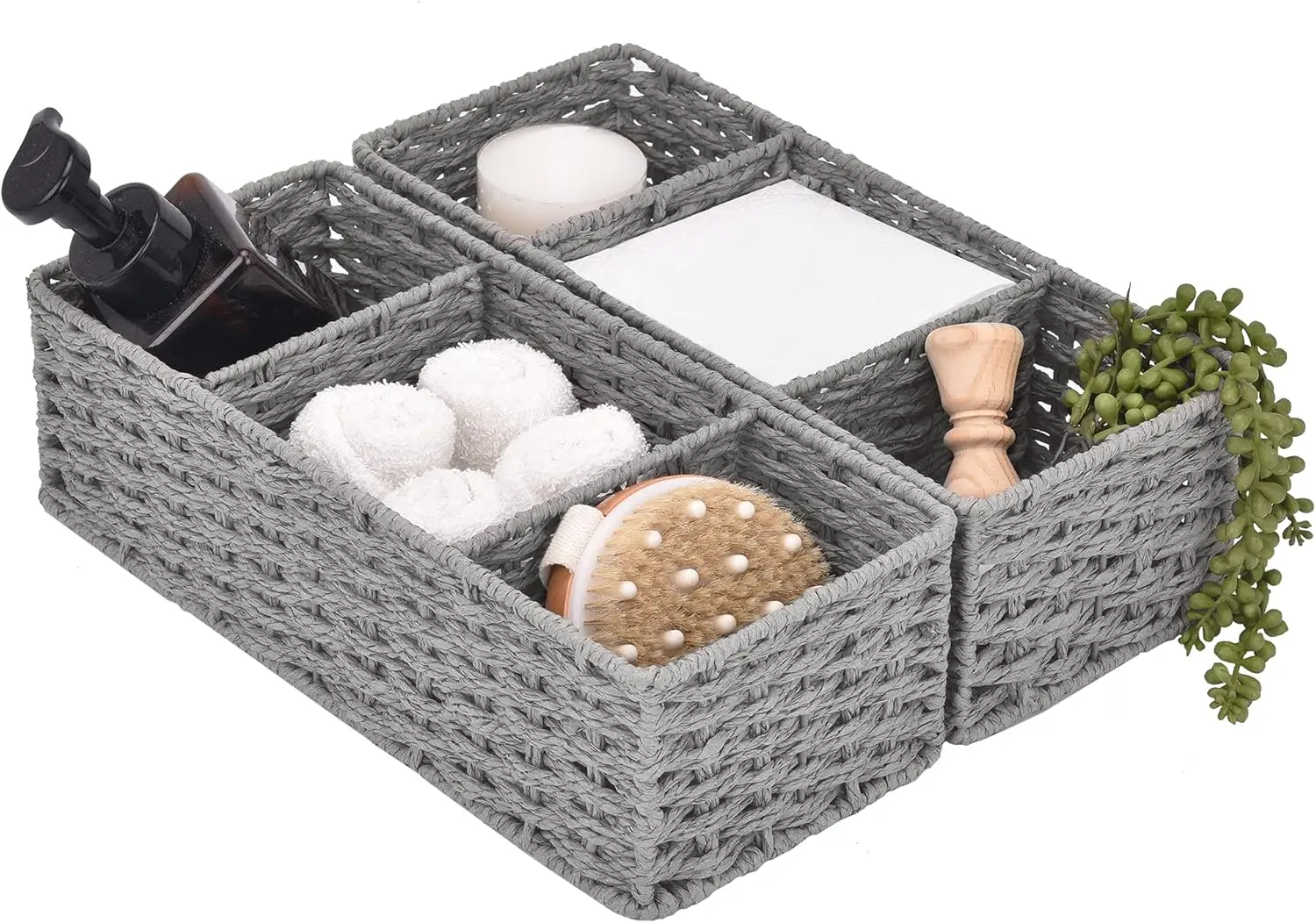
Consider how these common basket shapes influence perception:
Rectangular baskets create structured, orderly impressions and typically maximize storage space efficiency. Their straight lines echo architectural elements like shelving and doorways, creating natural harmony in traditional, contemporary, and transitional spaces.
Square baskets project balance and stability. They fit perfectly in cube storage systems and create pleasing geometric repetition when grouped. Their equal proportions make them particularly suitable for minimalist and modern interiors.
Round wicker baskets introduce softer, more organic elements that counterbalance angular furniture. Their curved forms create visual interest and movement, making them excellent accent pieces in rooms dominated by straight lines. They work beautifully in bohemian, coastal, and eclectic interiors.
Oval and oblong shapes combine the softness of rounds with increased storage capacity. Their elongated form makes them ideal for narrow spaces like consoles or under benches while maintaining organic appeal.
The relationship between basket shape and room geometry deserves careful consideration:
- Rooms with predominantly angular architecture (exposed beams, rectangular windows) benefit from some curved basket elements to prevent visual rigidity
- Spaces with many curved architectural features (arched doorways, round windows) maintain coherence with similarly curved basket forms
- Mixed-geometry spaces can use both angular and curved baskets as transitional elements between different architectural features
When deciding on consistent versus mixed shapes:
– Consistent shapes create stronger visual impact and a more formal, intentional appearance
– Mixed shapes offer greater functional versatility and a more relaxed, collected-over-time aesthetic
– Even when mixing shapes, maintaining consistent materials or colors preserves cohesion
The visual impact of shape extends to profile as well:
– Tapered baskets (wider at top than bottom) appear lighter and more dynamic
– Straight-sided baskets project stability and maximize capacity
– Curved-profile baskets add sculptural interest even when contents are hidden
Shape selection ultimately balances aesthetic preference with storage requirements—the most successful choices satisfy both simultaneously.
Practical Features: Ensuring Functionality Meets Style
While aesthetics are vital in selecting matching storage baskets, practical features determine how effectively they’ll serve your organizational needs. The most beautiful basket will become frustrating if it doesn’t function well for its intended purpose.
Key features to consider include:
Lid Options
Wicker baskets with lids offer distinct advantages:
– Conceal contents completely for a cleaner appearance
– Protect items from dust and light exposure
– Allow secure stacking for vertical storage
– Create a more finished, intentional look
Open baskets provide different benefits:
– Offer easy access to frequently used items
– Allow visibility of contents without opening
– Provide ventilation for certain items (like laundry)
– Often display decorative contents as part of your design
Handle Variations
– Cutout handles save space but may be less comfortable for heavier loads
– Rope or fabric handles add textural contrast and comfortable grip
– Metal or wood handles provide durability but add weight
– Side handles versus top handles affect how baskets are carried and stored
Interior Features
– Fabric liners protect both basket and contents from damage
– Removable liners allow for easy cleaning
– Dividers organize smaller items within larger baskets
– Waterproof linings protect baskets in moisture-prone areas
Specialty Functions
– Stackable designs maximize vertical storage
– Collapsible options save space when not in use
– Label holders help identify contents without opening
– Reinforced bottoms support heavier items
The most successful baskets balance their visual appeal with these practical considerations. For example, a living room basket might prioritize an attractive lid and comfortable handles, while a bathroom basket might emphasize moisture resistance and easy cleaning.
When investing in storage solutions, consider how your needs might evolve. Versatile baskets with removable components often provide greater long-term value than highly specialized designs. The ideal is finding beautiful baskets whose features enhance rather than compromise your organizational systems.
Creating a Cohesive Basket Collection: Strategic Approaches
Building a collection of storage baskets that work harmoniously throughout your home requires strategic thinking. Rather than purchasing baskets individually as needs arise, approaching your storage as a curated collection yields more sophisticated results.
Several effective strategies exist for creating cohesive basket groupings:
The Matched Set Approach
Using identical baskets throughout a space creates maximum visual continuity and an intentionally designed appearance. This approach works particularly well in:
– Open-concept spaces where storage is highly visible across areas
– Minimal or contemporary interiors where clean uniformity is valued
– Situations where organizational clarity is paramount (family systems, shared spaces)
The key to success with this approach is selecting versatile baskets that function well across different storage needs while maintaining visual appeal.
The Complementary Materials Strategy
This approach uses different basket styles and shapes that share common materials. For example, various water hyacinth baskets with different weaves and structures maintain connection while offering appropriate solutions for diverse storage needs. This strategy:
– Provides greater functional flexibility than identical baskets
– Creates subtle visual interest through variations while maintaining cohesion
– Allows incorporation of specialized storage features where needed
Color Family Cohesion
Using baskets in a consistent color palette while varying materials, shapes, and sizes creates unity with diversity. This works especially well when:
– Different rooms require different basket types but visual flow between spaces is important
– You want to incorporate existing storage pieces into a more cohesive system
– Your storage needs are highly varied but visual harmony is a priority
Elevating home decorating with matching wicker baskets becomes simpler when focusing on color relationships rather than identical matches.
Textural Harmony
This approach prioritizes consistent texture while allowing variation in other elements. For example, all baskets might feature open weaves but in different materials or colors. This creates:
– A sophisticated “collected” look that doesn’t appear overly matched
– Tactile consistency that ties diverse spaces together
– Visual interest through subtle variations within a consistent textural theme
The Furniture-Matching Method
Selecting baskets that echo materials, finishes, or design elements from your furniture creates natural harmony. For instance, baskets with wood handles that match your coffee table tone, or weaves that reference patterns in your upholstery. This approach:
– Integrates storage seamlessly into your existing design
– Creates sophisticated connections between elements
– Works well when introducing storage to already-established spaces
Most successful homes use a combination of these approaches, perhaps employing matched sets within rooms while using color family cohesion to connect different spaces. The key is intentionality—making conscious decisions about how your storage elements relate to each other and your overall design.
Room-by-Room Storage Basket Applications
Different rooms present unique storage challenges and opportunities. Tailoring your basket selections to each space’s specific needs ensures both functional success and aesthetic cohesion throughout your home.
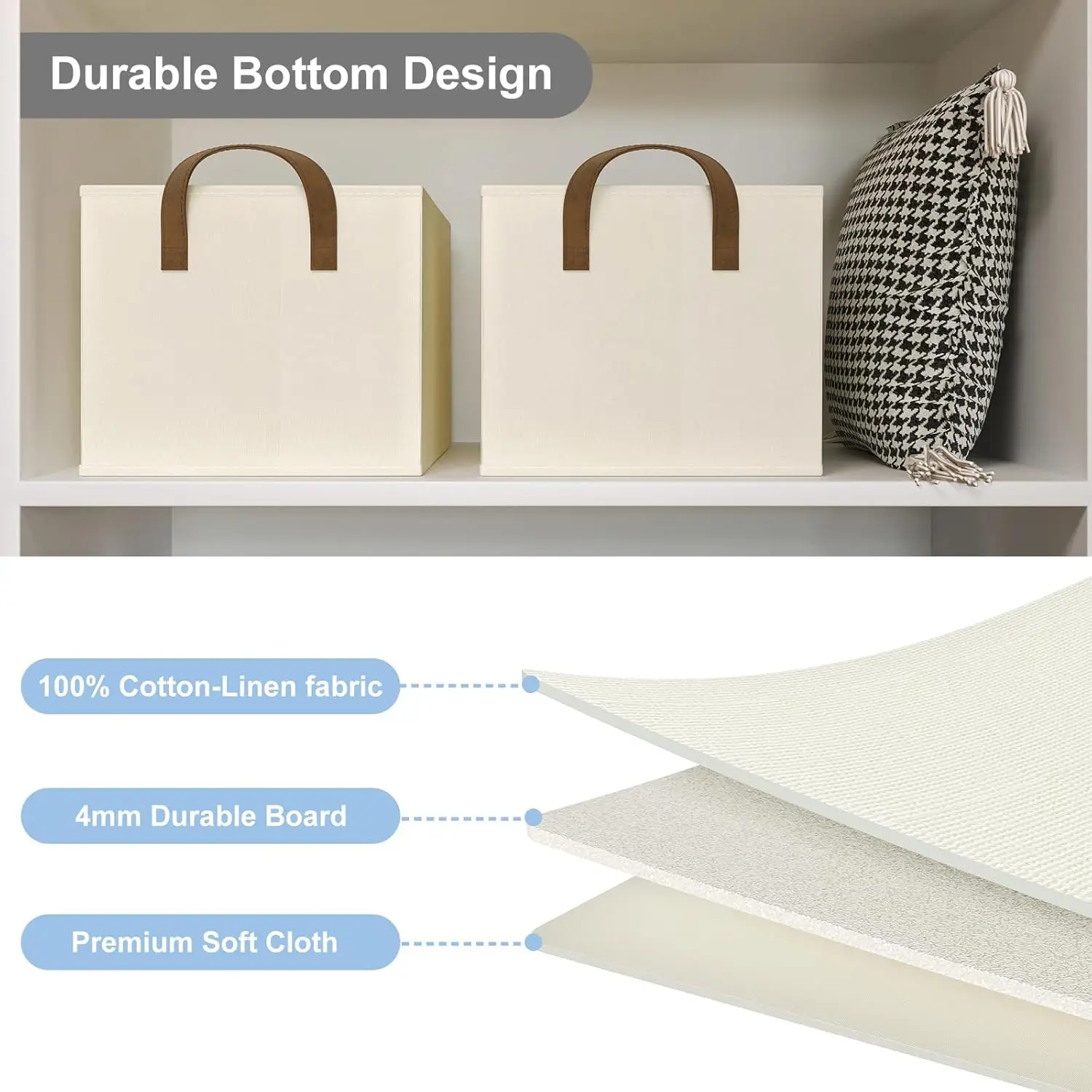
Living Room
The living room often requires the most visible storage, making aesthetic quality particularly important:
– Large baskets (16-20 inches wide) for throw blankets and pillows
– Medium baskets with lids for remote controls, gaming equipment, and electronics
– Low, wide baskets that slide under coffee tables for magazines and books
– Decorative open baskets that double as display for collections or seasonal items
For living areas, prioritize materials and colors that complement your primary furniture. Baskets here should enhance rather than simply serve your space.
Bedroom
Bedroom storage balances visibility with concealment:
– Under-bed baskets with lids protect off-season clothing from dust
– Bedside baskets (8-10 inches) contain personal items and reading materials
– Handled baskets in closets organize accessories, scarves, and smaller garments
– Decorative baskets on dressers corral jewelry, watches, and everyday essentials
Consider both practical access and the restful atmosphere you want to create when selecting bedroom baskets.
Bathroom
Moisture resistance and cleanability take priority in bathrooms:
– Small countertop baskets (6-8 inches) for daily toiletries
– Medium baskets with liners for towels and washcloths
– Narrow baskets that fit between fixtures for maximizing limited space
– Lidded baskets for concealing personal products and cleaning supplies
Natural materials like seagrass and water hyacinth resist moisture better than many alternatives, making them excellent bathroom choices.
Entryway
The entryway requires durable, practical storage that makes good first impressions:
– Individual small baskets for each family member’s everyday items
– Narrow vertical baskets for umbrellas and walking sticks
– Lidded baskets to discreetly contain mail and keys
– Sturdy floor baskets for shoes and boots
Creating a uniform look with baskets throughout the home becomes particularly visible in the entryway, which connects to other spaces.
Kitchen
Kitchen baskets must balance attractiveness with food safety and practicality:
– Open weave baskets for fruits and vegetables that need ventilation
– Lined baskets for bread and dry goods
– Small divided baskets for organizing pantry items by category
– Handled baskets that can move from storage to table for serving
Wipeable materials or washable liners are essential for kitchen applications.
Home Office
Organization meets inspiration in office basket selection:
– Desktop baskets (4-6 inches) for containing supplies without overwhelming workspace
– Filing baskets that accommodate standard document sizes
– Cable management baskets that conceal electronic clutter
– Rolling underdesk baskets for supplies that need frequent access
Look for baskets with internal divisions or pair with smaller containers for maximum organizational impact.
Kids’ Spaces
Durability, safety, and accessibility drive children’s storage choices:
– Low, open baskets that encourage independent cleanup
– Picture-labeled baskets for pre-readers
– Lightweight options that children can move independently
– Soft-sided fabric baskets that won’t cause injury during active play
Consider growth when investing in children’s storage—neutral baskets with changeable labels or liners adapt as interests evolve.
Black Wicker Baskets, Rattan Storage Baskets, Tall Wicker Baskets, Wicker Shelf Baskets, Woven Storage Baskets
5-Tier Distressed Black Wood Frame Storage Tower with Removable Wicker Baskets for Home Organization$715.80 Select options This product has multiple variants. The options may be chosen on the product pageWicker Laundry Baskets, Woven Laundry Baskets, Woven Storage Baskets
$392.02 Select options This product has multiple variants. The options may be chosen on the product pageRattan Shelf Baskets, Rattan Storage Baskets, Small Wicker Baskets, Square Wicker Baskets
Square Plastic Wicker Storage Baskets Set of 3 with Collapsible Design for Cube Storage Organization$185.47 Select options This product has multiple variants. The options may be chosen on the product pageWicker Baskets with Handles, Wicker Storage Baskets, Woven Storage Baskets
$137.92 Select options This product has multiple variants. The options may be chosen on the product pageLarge Wicker Laundry Baskets, Tall Wicker Baskets, Woven Laundry Hampers, Woven Storage Baskets
$130.54 Select options This product has multiple variants. The options may be chosen on the product pageRattan Shelf Baskets, Rattan Storage Baskets
$345.47 Select options This product has multiple variants. The options may be chosen on the product page
Practical Considerations Beyond Aesthetics
While style remains important, practical factors significantly impact your long-term satisfaction with storage baskets. Understanding these considerations helps you make informed investments rather than purchasing based solely on appearance.
Durability Factors
Different materials offer varying lifespans under regular use:
– Natural rattan and thick seagrass typically last 5-8 years with proper care
– Quality water hyacinth can maintain its appearance for 3-5 years
– Canvas and fabric baskets may need replacement after 2-3 years of heavy use
– Metal and wood options often provide the longest lifespan at 8+ years
Construction quality matters as much as material—look for:
– Tight, consistent weaving without gaps
– Reinforced handles and corners
– Sturdy base construction
– Quality hardware and fasteners
Maintenance Requirements
Regular care extends basket lifespan significantly:
– Natural fiber baskets benefit from occasional dusting and monthly vacuuming with a soft brush attachment
– Most natural baskets should avoid direct sunlight, which causes fading and brittleness
– Fabric baskets often allow machine washing, but check individual care instructions
– Waterproofed or treated baskets require specific cleaning methods to maintain their protective qualities
Budget Considerations
Price ranges vary significantly based on materials, size, and construction:
– Basic fabric cubes typically range from $10-25 each
– Mid-range natural fiber baskets without special features average $25-60
– Premium handcrafted or designer baskets can range from $60-200+
Smart investment strategies include:
– Investing more in highly visible baskets that impact your design significantly
– Economizing on utility baskets in closets or other hidden areas
– Purchasing matched sets when available for cost savings
– Considering seasonal sales at specialty retailers
Knowing where to buy matching home storage helps you find quality options within your budget. Specialty home stores often provide better construction than discount retailers, though at higher price points.
Sustainable Options
Environmentally conscious consumers should consider:
– Rapidly renewable materials like seagrass, water hyacinth, and bamboo
– Baskets made from recycled materials (recycled cotton, plastic, or metal)
– Products with transparent sourcing and fair labor practices
– Longevity as a key sustainability factor—quality pieces that won’t need frequent replacement
The most sustainable choice is often investing in versatile, durable baskets that serve multiple purposes throughout their lifespan rather than specialized items with limited applications.
Common Styling Mistakes to Avoid
Even with beautiful baskets, several common arrangement mistakes can undermine your organizational and aesthetic goals. Avoiding these pitfalls helps maximize both the function and appearance of your storage solutions.
Overcrowding Spaces
One of the most frequent errors is using too many baskets in a limited area:
– Overcrowded shelves lose visual breathing room
– Excessive baskets can make spaces feel smaller and more cluttered
– Multiple competing baskets create visual noise rather than organization
Solution: Follow the design rule of leaving at least 10-20% empty space on shelves and surfaces. This negative space allows your baskets to become features rather than overwhelming elements.
Mismatched Styles Creating Visual Chaos
While exact matching isn’t necessary, completely unrelated baskets can create discord:
– Highly different materials without a unifying element create disjointed appearance
– Clashing colors draw attention to storage rather than the overall design
– Mixing formal and casual basket styles can feel unintentional
Solution: Identify at least one unifying element (color family, material type, or weave pattern) to maintain across different basket styles. This creates cohesion even among varied pieces, similar to how matching laundry baskets to home decor creates visual harmony.
Ignoring Scale and Proportion
Baskets that are too large or too small for their spaces create visual imbalance:
– Oversized baskets overwhelm delicate furniture
– Tiny baskets on substantial pieces look insignificant
– Inconsistent sizing across grouped baskets appears haphazard
Solution: Select baskets that occupy approximately 1/2 to 2/3 of their designated space (width of shelf, area under console, etc.) for proper visual weight.
Prioritizing Looks Over Function
Beautiful but impractical baskets quickly become frustrating:
– Hard-to-open lids discourage regular use
– Baskets too heavy to move easily when filled
– Rough materials that snag delicate items
– Unstable designs that tip when accessed
Solution: Test functionality before committing—open and close lids, lift with simulated weight, and consider how you’ll interact with the basket daily.
Neglecting Ease of Access
Organizational systems fail when they’re too complicated:
– Baskets stacked too high become inaccessible
– Deep baskets that require extensive searching for small items
– Storage that requires moving multiple pieces to reach needed items
Solution: Place frequently used items in easily accessible baskets with open or simple-open tops. Reserve more complex storage solutions for less frequently accessed belongings.
Using Inappropriate Materials for Specific Items
Not all basket materials suit all contents:
– Storing heavy books in lightweight, flexible baskets causes warping
– Placing damp items in untreated natural fibers leads to mold
– Storing sharp objects in loosely woven baskets results in snagging and damage
Solution: Match material properties to contents—rigid constructions for heavy items, moisture-resistant materials for bathroom or kitchen use, and tightly woven options for small items.
By avoiding these common mistakes, you’ll create storage solutions that maintain their beauty and functionality for years to come.
Is It Worth Investing in High-Quality Storage Baskets?
The question of investing in premium storage baskets versus budget options requires considering multiple factors beyond initial price. Understanding the value proposition helps you allocate your budget effectively across different storage needs.
Long-Term Value Assessment
Higher-quality baskets typically offer:
– Extended lifespan (often 3-5 times longer than budget alternatives)
– Better construction that maintains appearance over time
– Materials that age gracefully rather than deteriorating
– Designs that remain relevant beyond trend cycles
When analyzed as cost-per-use, premium baskets often become more economical over time, particularly for everyday storage solutions in high-visibility areas.
Where Quality Matters Most
Certain applications justify higher investment:
– Heavily used baskets that face daily handling
– Visually prominent locations where aesthetics significantly impact your space
– Storage for valuable or delicate items requiring better protection
– Baskets that need to support substantial weight consistently
Quality coordinated basket collections provide particular value when used throughout open-concept homes, where visual continuity across spaces enhances the entire environment.
When Budget Options Suffice
More economical choices may be appropriate for:
– Temporary storage needs or transitional spaces
– Closets and utility areas with limited visibility
– Children’s spaces where needs change rapidly with age
– Seasonal storage used only briefly each year
Recognizing Quality Indicators
When shopping, look for these markers of superior construction:
– Tight, consistent weaving with reinforced edges
– Substantial weight relative to size (indicates denser materials)
– Smooth, finished edges without sharp points or fraying
– Sturdy, well-attached handles that support the basket’s capacity when full
– Quality hardware like hinges and closures that operate smoothly
The Middle Ground Approach
Many homeowners find success with a tiered approach:
– Investing in 3-5 premium “anchor” baskets for high-visibility, high-use locations
– Selecting mid-range options for secondary spaces
– Using budget baskets for utility areas or short-term needs
This strategy concentrates quality where it creates the most impact while managing overall cost.
The decision ultimately balances immediate budget constraints against long-term satisfaction and replacement costs. For many homeowners, a few carefully selected quality pieces provide better value than numerous replacements of inferior alternatives.
How Can You Use Storage Baskets to Change a Room’s Atmosphere?
Beyond organization, strategically chosen storage baskets can dramatically transform a room’s aesthetic and emotional impact. They offer one of the most accessible ways to refresh your interior without major renovations or furniture investments.
Adding Warmth to Minimal Spaces
Modern and minimal interiors sometimes feel cold or sterile. Natural fiber baskets introduce:
– Organic textures that soften hard edges and surfaces
– Warm tones that balance cool color palettes
– Handcrafted elements that add human touch to manufactured environments
Contemporary applications for natural baskets demonstrate how traditional materials can beautifully complement even the most modern spaces, creating welcome tension between sleek and organic elements.
Creating Order in Visually Busy Rooms
In spaces with bold patterns, multiple colors, or eclectic furnishings, cohesive storage brings balance:
– Uniform baskets create visual rest points amidst complexity
– Coordinated containers frame and organize diverse elements
– Consistent storage solutions provide structure without diminishing character
The transformation can be dramatic—a bohemian space filled with varied colors and patterns gains sophistication when accessories are gathered in matching natural baskets.
Seasonal Refreshes Through Basket Rotation
Changing baskets seasonally offers affordable design refreshes:
– Summer: Lightweight, pale baskets with open weaves for airy feel
– Fall: Richer tones and more substantial materials for coziness
– Winter: Lined baskets with textural contrast for warmth and comfort
– Spring: Introduce color through baskets with fresh hues or patterns
This approach provides design flexibility without major investment, allowing your space to evolve with the seasons.
Experimenting with Design Trends
Storage baskets offer low-commitment ways to incorporate current trends:
– Try on-trend colors through baskets before committing to larger pieces
– Experiment with fashionable materials or patterns in smaller storage elements
– Introduce new style influences gradually through accessory pieces
If a trend doesn’t resonate with you long-term, repurposing baskets to closets or utility spaces is simpler than replacing furniture.
Even subtle basket changes can shift perception—replacing rigid rectangular baskets with softly rounded alternatives immediately softens a room’s appearance, while introducing baskets with metallic elements instantly adds contemporary sophistication to traditional spaces.
The transformative power of thoughtfully selected storage should not be underestimated. As both functional necessities and design elements, baskets offer unique opportunities to shape how your space feels and functions.
Will Matching Storage Baskets Actually Help Keep My Home Organized?
The question of whether attractive storage truly improves organization is important—after all, the primary purpose of baskets is functional. Evidence suggests that aesthetically pleasing storage does indeed enhance organizational success, but understanding why helps leverage this effect.
The Psychology of Beautiful Organization
Research in environmental psychology indicates that:
– People are more likely to maintain systems they find visually appealing
– Attractive storage reduces the negative associations with cleanup tasks
– Visible, aesthetically pleasing organization systems create accountability
– Beautiful containers elevate the perceived value of the organization process itself
When storage becomes something you’re proud to display rather than hide, maintaining order becomes more rewarding.
Visual Cues for Organizational Maintenance
Matching baskets create powerful visual cues that support organization:
– Consistent containers make it immediately apparent when items are out of place
– Uniform storage makes it easier to recognize when systems need adjustment
– Coordinated baskets create visual “homes” for belongings that are easier to remember
– The visual harmony of matched storage reinforces the satisfaction of completion
The Balance of Concealed and Visible Storage
Effective organization systems typically balance:
– Concealed storage for items that create visual clutter
– Open storage for frequently accessed belongings
– Semi-visible storage (like textured baskets) that obscures contents while maintaining accessibility
This balance ensures convenience without sacrificing aesthetics, making daily maintenance more likely.
Family Adoption of Systems
One significant advantage of attractive storage is increased family participation:
– Visually distinct baskets create clear systems even younger family members can follow
– Aesthetically pleasing containers reduce resistance to cleanup activities
– Matching baskets can be color-coded or otherwise visually differentiated for different family members
– Beautiful storage elevates the perceived importance of maintaining organization
The key to success is pairing beautiful baskets with thoughtful organizational systems. Even the most attractive baskets will fail to maintain order without logical categorization, appropriate sizing, and strategic placement. The ideal approach combines:
- Careful assessment of what needs storage
- Logical grouping of related items
- Selection of appropriately sized and styled baskets
- Strategic placement for convenience
- Clear, sustainable systems for maintenance
When these elements work together, matching storage baskets become powerful tools for both beautiful interiors and functional organization—truly creating harmony between order and design.

